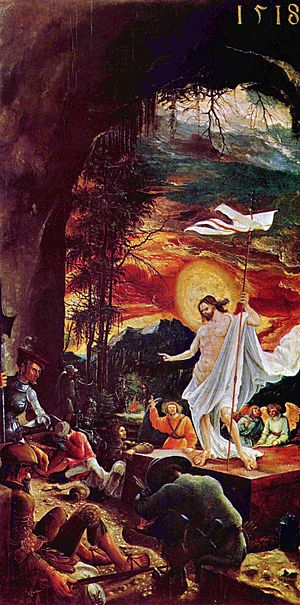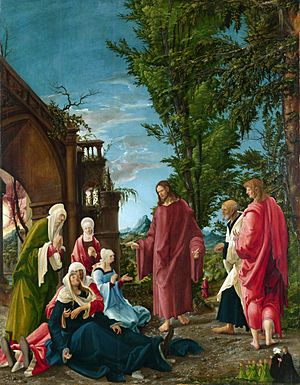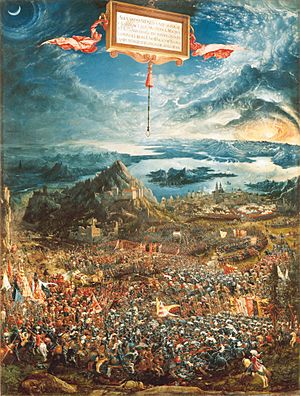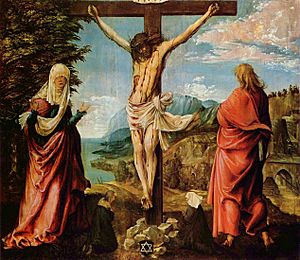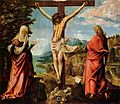Albrecht Altdorfer facts for kids
Quick facts for kids
Albrecht Altdorfer
|
|
|---|---|

Albrecht Altdorfer portrait by Philipp Kilian
|
|
| Born | c. 1480 Regensburg or Altdorf
|
| Died | 12 February 1538 (aged 57–58) |
| Nationality | German |
Albrecht Altdorfer (around 1480 – 12 February 1538) was an important German artist during the Renaissance. He was a painter, engraver, and architect who worked in Regensburg, Bavaria.
Altdorfer is known as a main artist of the Danube School. This group of artists was famous for painting biblical and historical scenes with very colorful and expressive landscapes in the background. He was one of the first artists to make landscapes the main subject of his paintings. He also created small, detailed engravings, which connects him to a group called the Little Masters from Nuremberg.
Contents
Life of a Renaissance Artist
Albrecht Altdorfer was born in Regensburg or Altdorf around 1480. He learned about art from his father, Ulrich Altdorfer, who was also a painter.
Altdorfer became well-known early in his career for his small, detailed artworks. He used unusual materials and subjects. In 1505, he settled in Regensburg, a city on the Danube River. He later became the city's architect and a city council member. His first signed artworks, including engravings, appeared around 1506. He was inspired by artists like Jacopo de Barbari and Albrecht Dürer.
Around 1511, Altdorfer traveled along the Danube River and into the Alps mountains. The beautiful scenery deeply impressed him. This trip made him one of the first true landscape painters in the modern sense. He became a leader of the Danube School, a group that started painting landscapes as their main subject in southern Germany.
From 1513, he worked for Emperor Maximilian I in Innsbruck. He received many art jobs from the royal court. During a time of big changes called the Protestant Reformation, he focused mostly on architecture. His paintings from this time, like Nativity of the Virgin, show his growing interest in buildings.
In 1529, he painted The Battle of Alexander at Issus for Duke William IV of Bavaria. By the 1520s, Altdorfer was a wealthy man and a member of Regensburg's city council. He was also in charge of strengthening the city's defenses.
Later in his life, his art was influenced by artists like Giorgione and Lucas Cranach the Elder. This can be seen in his Crucifixion. He visited Vienna in 1535 and died in Regensburg in 1538.
Altdorfer created a large amount of art during his career, from 1504 to 1537. His surviving works include 55 paintings, 120 drawings, 125 woodcuts, 78 engravings, 36 etchings, and 24 paintings on parchment. He signed and dated all his works.
Altdorfer's Paintings
Altdorfer was a pioneer in painting pure landscapes. He made nature the main subject of his art, or he painted scenes where the landscape was the most important part. He believed that people in a painting should fit into nature, not stand out from it.
He developed the landscape style of Lucas Cranach the Elder. Altdorfer often showed the hilly Danube valley with thick forests of fir and larch trees. He used dramatic colors, especially from rising or setting suns. His painting Landscape with Footbridge (1518–1520) is thought to be the first pure landscape painting done in oil. In this painting, a large tree is placed in the center, making it the main focus.
Altdorfer also made many detailed drawings, mostly landscapes, using pen and watercolour. An example is Landscape with the Woodcutter from 1522. This drawing shows a huge tree in the middle, taking over the picture. Some people think the tree looks like a human, with its branches spreading out. At the bottom of the tree, a small man sits, holding a knife and axe, showing his job.
He often painted historical and biblical scenes within these beautiful, atmospheric landscapes. His religious paintings are very strong, with bright lights and glowing colors. They often show close moments between Christ and his mother, or various saints. His most famous religious artwork is The Legend of St. Sebastian and The Passion of Christ from the Sebastian Altar at St. Florian's Priory near Linz. This altarpiece showed scenes from St. Sebastian's life and the Stations of the Cross. Today, parts of it are in the Kunsthistorisches Museum in Vienna.
Altdorfer sometimes used unusual perspectives in his art. In some paintings, the people who paid for the artwork (called "donor figures") are painted much smaller than the main scene. He also painted some portraits. In his later works, Altdorfer's style changed. He started to paint human figures more like the Italian style and used very bright colors.
Famous Paintings in Munich
One of Altdorfer's most famous paintings is The Battle of Alexander at Issus (1529). Duke William IV of Bavaria asked him to paint it as part of a series of eight historical battle scenes for his home in Munich.
This painting shows the moment in 333 BCE when Alexander the Great defeated Darius III. It is a huge and dramatic painting. Thousands of soldiers are shown, with Alexander on his white horse leading his army. Darius is shown fleeing in his chariot. The armies are easy to tell apart by their uniform colors: Darius's army is red, and Alexander's is blue.
The top part of the painting shows a vast landscape from a very high viewpoint. You can see a huge area of the world, from modern Turkey all the way to the Nile River and the Red Sea. The sun is shining brightly, symbolizing victory. Altdorfer made the soldiers blend into the landscape. This shows his belief that nature was just as important as the historical event itself. This painting is thought to be one of the earliest to show the curve of the Earth from a high view.
The Battle is now in the Alte Pinakothek museum in Munich. This museum has the best collection of Altdorfer's paintings. Another painting there is his small St. George and the Dragon (1510). In this oil painting on parchment, the figures are tiny and almost hidden by the thick, tall forest. Altdorfer made the forest seem much larger than the people and horse, showing how important nature was to him. He also used lines to show the forest growing upwards.
Another small oil painting on parchment, Danube Landscape with Castle Wörth (around 1520), is one of the earliest accurate paintings of a specific building in its natural setting.
Altdorfer as a Printmaker

Altdorfer was also a very important printmaker. He made many engravings and about ninety-three woodcuts. Some of these were for the Triumphs of Maximilian, where he followed the style set by Hans Burgkmair.
However, many of his best prints are etchings, especially of landscapes. In these, he could easily use his unique drawing style. He was one of the most successful early etchers. He often combined etching and engraving techniques in one print. Many of Altdorfer's prints are quite small, which is why he is considered one of the main members of the group known as the Little Masters.
Public Life and City Work
As the superintendent of city buildings, Altdorfer oversaw the construction of several important structures. These included a slaughterhouse and a building for storing wine, which he might have even designed himself. He was seen as an excellent politician in his time.
In 1517, he was a member of the "Ausseren Rates," which was the city council for outside affairs. In this role, he was involved in the building of a church and shrine to the Schöne Maria in 1519. Altdorfer created etchings of the inside of the synagogue that was replaced by the church, and he designed a woodcut of the Schöne Maria image. From 1529 to 1530, he was also responsible for strengthening the city's defenses because of a threat from the Turks.
Albrecht's brother, Erhard Altdorfer, was also a painter and printmaker. He was a student of Lucas Cranach the Elder.
See also
 In Spanish: Albrecht Altdorfer para niños
In Spanish: Albrecht Altdorfer para niños
- 8121 Altdorfer, asteroid named after Altdorfer
- Danube school
- Early Renaissance painting
- List of landscapes by Albrecht Altdorfer
Images for kids


